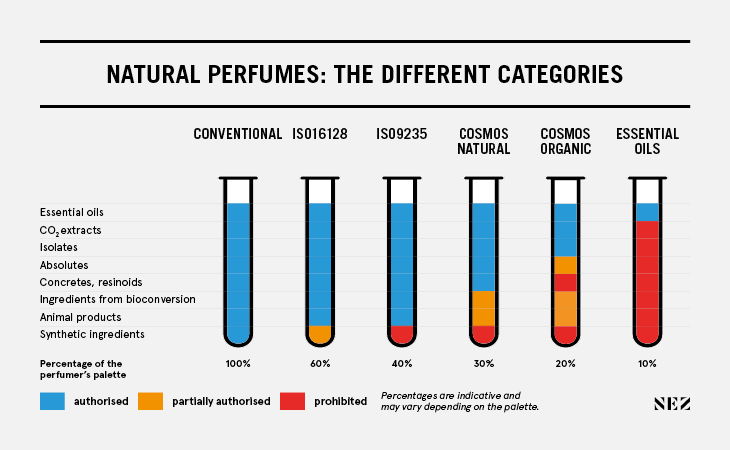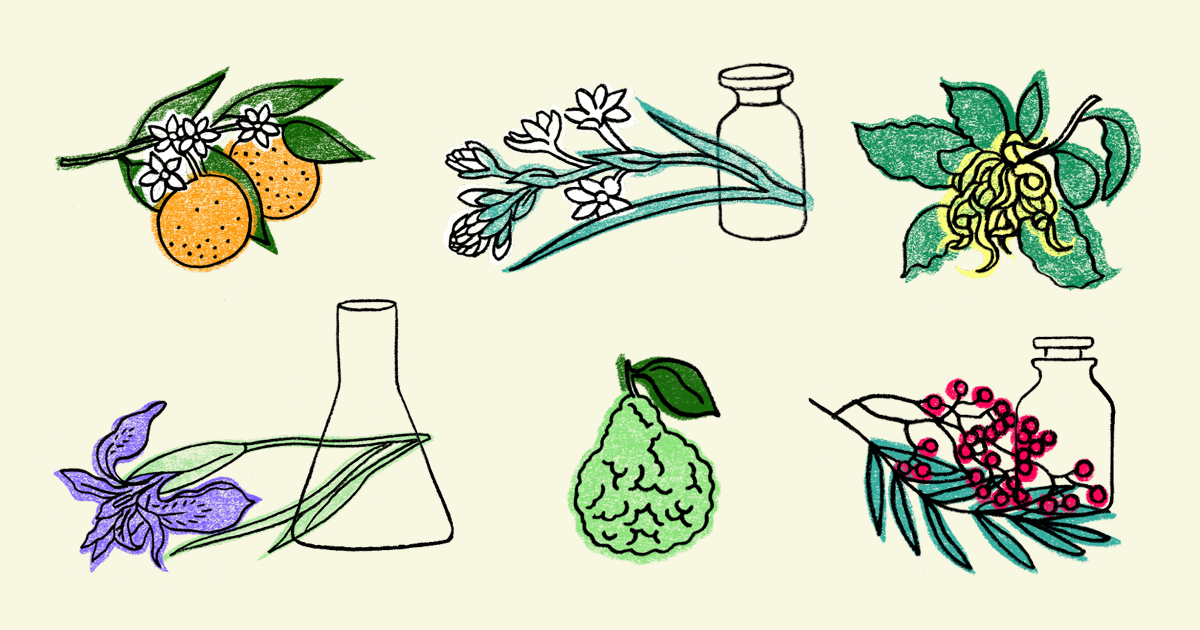Cette publication est également disponible en :
Français
My perfume is 100% natural. Yes, but what does that mean? What exactly does it contain? Well, it depends!
That’s because the notion of natural perfume has many different facets, which goes some way to explaining the olfactory versatility on display when we compare different brands. The fact is that perfume houses can choose from several standards and certifications to apply to their creations.
Here are the main choices, from the most restrictive to the most flexible.
Cosmos Organic
Applied at the European level to cosmetics and fragrances, this certification is granted by Ecocert and allows perfumers to use essential oils, CO2 extracts, natural isolates and only the absolutes obtained using naturally-sourced ethanol (such as vanilla and tonka bean absolutes).
It also accepts ingredients obtained from the bioconversion of natural raw materials as long as they are not GMOs and do not contain any residual solvent (such as certain lactones made from fermenting the fatty acids in vegetable oil, for example).
Ingredients sourced from animals must not cause the animal’s death (this is the case for beeswax but not castoreum).
20% or less of the final product’s ingredients must be certified organic as well as 95% of the plant-based ingredients.
This represents around 20% of the perfumer’s palette.
Cosmos Natural
Added to the list of raw materials authorised by Cosmos Organic are all absolutes, concretes and resinoids obtained with petrochemical solvent, such as hexane, as well as ingredients obtained from the bioconversion, including those whose bioconversion involves synthetic solvents, but without the minimum percentage of organic ingredients.
ISO 9235
The standard that corresponds to the IFRA definition of a 100% natural perfume.
Added to the list of raw materials authorised by Cosmos Natural are all animal products and all ingredients obtained from bioconversion, without any restriction.
This represents around 40% of the perfumer’s palette.
ISO 16128
Applied to both cosmetics and fragrances, this standard does not exclude any raw materials. It allows companies to claim a percentage of natural or naturally-sourced ingredients. The ingredients can be obtained by synthetic means, even when they do not exist in nature, as long as they contain over 50% of renewable carbon (like ambroxan, synthetized using clary sage).
These definitions show that the notion of naturalness brands lay claim to, without being detailed, is far more complex (and sometimes more flexible) than it might appear.
Here is a diagram showing the different formulation possibilities, from conventional perfume (where all ingredients alre allowed, according to IFRA rules) to a formula containing nothing but essential oils.
The type of authorised ingredients and percentage of the perfumer’s palette represented are indicated for each option.

And in order to be able to understand what each type of ingredient corresponds to, we remind you here the definitions:
Absolute
Refined product, without waxy substances, obtained by an alcohol wash of the concrete (itself obtained from a volatile solvant extraction of a natural raw material).
Animal materials
The main animal ingredients currently used, but relatively rarely, are beeswax absolute (which does not cause the insect to die) and castoreum (which involves killing the beavers). Ambergris and civet are used in very rare perfumes and do not require the sperm whale or civet to be killed. The use of natural musk, which caused the chevrotain to die, is strictly forbidden in perfumery. And hyraceum, the petrified urine of a rodent and an ingredient that is scarcely ever used, does not involve the animal dying.
Bioconversion
This process consists of making use of the properties of microorganisms (enzymes, bacteria, etc.) to transform a natural raw material into one or more aroma compounds.
CO₂ extract
Product obtained through CO₂ extraction: carbon dioxide at high pressure and high temperature reaches a state known as supercritical, when it acts like a solvent to extract the plant’s odorant compounds. Once it expands, the CO₂ returns to a gaseous state, leaving an extract with no residue.
Concrete
A waxy product, solid or semi-solid, obtained via volatile solvent extraction of the aromatic matter of a natural raw material. After being washed with alcohol, the concrete produces an absolute.
Essence or essential oil
Odorant compounds obtained by distillation or cold expression of natural raw materials.
Different methods can be used for distillation: steam distillation where water, heated in a chamber, produces steam which is forced through the organic matter, taking its aroma compounds with it; and hydrodistillation, which involves immersing the materials in boiling water, when the steam generated by this heated mixture draws out the odorous compounds.
Isolate
Odorant compound which can be obtained from fractional distillation of an essential oil, which separates it from the other components. For example, citronellol can be isolated in eucalyptus essential oil, which contains it.
Resinoid
Product obtained by using volatile solvent extraction on the dry part of plant-based raw materials or certain balsams, resins and gums.
Our thanks to Serge De Oliveira (Robertet), Irène Farmachidi and Médrick Germain (Technicoflor), Pauline Raffaitin (Ecocert) and Delphine Thierry (Inspiration libre) for their explanations and invaluable help.
Natural perfumers – Summary
- Introduction, by Jeanne Doré
- Hiram Green: “If people want to buy my perfumes, it should be because they like their smell“
- Caroline Dumur: “Without synthetics, you have to learn to formulate differently”
- Delphine Thierry: “To formulate 100% natural perfumes, I set aside almost everything I’ve learned so far”
- Isabelle Doyen and Camille Goutal: “For us, 100% natural is a perfumer’s challenge rather than a marketing position.”
- Serge de Oliveira: “Most clients want natural perfumes that are just like conventional fragrances”
- Irène Farmachidi: “In 100% natural perfumery, we formulate by using paraphrases, it’s like a game”
- Mandy Aftel: “Mixing a bunch of natural ingredients in a bottle does not produce a perfume”
- Our selection of natural perfumes
- The many facets of natural perfumery
- Natural perfumes: conclusion and a few thoughts
Illustration by Marion Duval for Nez.
More about raw ingredients for perfumery on ScenTree.co.








“The use of natural musk […] is strictly forbidden in perfumery”.
I’m very interested in this topic. Is it possible to give more details about it, to specify which act or organism issued the interdiction? Because there are multiple perfume brands that curently use deer musk in their fragrances such as Areej le Doré, Bortnikoff, Ensar Oud, Meleg.
Thank you!
Dear Roxana,
After asian musk deer populations were decimated, the animal is now protected by the Convention on International Trade in Endangered Species of Wild Fauna and Flora (CITES) In 1973, the Washington Convention text was adopted at a meeting of representatives from 80 countries, and it came into effect in 1975.
There have been experiences conducted to produce musk in captivity but they have been inconclusive.
However, musk Tonkin may be still illegally obtained by poaching, mainly in the Middle East, China or Russia.
I don’t know about these brands, it is likely to be still used in some cases, but very often, claimed “musk Tonkin” is actually a reconstitution based on other raw materials.
The best would be to ask directly these brands about it.
Jeanne
Thank you for your response!
I knew about the Convention so that is why I was intrigued.
The Convention forbids the internationally trade in deer musk only for six counties, and imposses restrictions for the rest of those that have populations of Moschus, which means they can export this musk under certain strict conditions.
Things are more clear now.
Thank you very much again!